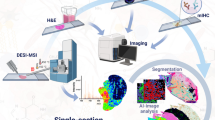Summary
Concentrations of AMSA were determined by HPLC in autopsy tissue samples from five patients who had received the drug antemortem. Relative organ concentrations of AMSA varied from patient to patient; however, concentrations were generally highest in gallbladder, liver, and kidney, while low levels were generally but not invariably found in lung, testicle, muscle, fat, spleen, bladder, pancreas, colon, prostate, and brain. One patient with ventricular fibrillation and seizures had high tissue AMSA concentrations in myocardium, but low concentrations in brain. Another patient with seizures during treatment had high brain concentrations of AMSA. Relative organ concentrations were similar to those found in mice, except that mice have high AMSA concentration in their spleens whereas our patients did not, even when the spleen was infiltrated with leukemic cells. High tissue concentrations of AMSA were still present 2 weeks after treatment. AMSA concentration was lower in a renal oncocytoma (1.1 μg/g) than in surrounding kidney (2.4 μg/g).
Similar content being viewed by others
Abbreviations
- AMSA:
-
4′-(9-acridinylamino)-methanesulfon-m-anisidide
- HPLC:
-
high-performance liquid chromatography
- AML:
-
acute myelogenous leukemia
- LLD:
-
lower limit of detection
References
Cabanillas F, Legha S, Bodey G, Freireich E (1981) Initial experience with AMSA as single-agent treatment against malignant lymphoproliferative disorders. Blood 57:614–616
Cysyk R, Shoemaker D, Adamson R (1977) The pharmacologic disposition of 4′-(9-acridinylamine)methanesulfon-m-anisidide in mice and rats. Drug Metab Dispos 5:579–589
Dorn RT, Fritz WL (1980) Cancer chemotherapy handbook. Elsevier/North Holland, New York
Drewinko B, Yang L, Barlogie B (1982) Lethal activity and kinetic response of cultured human cells to 4′-(9-acridinylamino)methanesulfon-m-anisidide. Cancer Res 42:107–111
El Dareen SJ, Mulligan LT Jr, White V, Tillery K, Mellett LB, Hill DL (1978) Distribution of (3H) cytosine arabinoside and its products in mice, dogs, and monkeys and effects of tetrahydrouridine. Cancer Treat Rep 61:395–407
Falkson G (1979) Multiple ventricular extrasystoles following administration of 4′-(9-acridinylamino)methanesulfon-m-anisidide (AMSA) Cancer Treat Rep 63:358
Houghton A, Camacho F, Wittes R, Young C (1981) Phase II study of AMSA in patients with metastatic malignant melanoma. Cancer Treat Rep 65:170–171
Legha S, Gutterman J, Hall S, Benjamin R, Burgess M, Valdivieso M, Bodey G (1978) Phase I clinical investigation of 4′-(9-acridinylamino)methanesulfon-m-anisidide (NSC 249992), a new acridine derivative. Cancer Res 38:3712–3716
Legha S, Blumenschein G, Buzdar A, Hortobagyi G, Bodey G (1979a) Phase II study of 4′-(9-acridinylamino)methanesulfon-m-anisidide (AMSA) in metastatic breast cancer. Cancer Treat Rep 63:1961–1964
Legha S, latreille J, McCredie K, Bodey G (1979b) Neurologic and cardiac rhythm abnormalities associated with 4′-(9-acridinylamino)methane-m-anisidide (AMSA) therapy. Cancer Treat Rep 63:2001–2003
Legha S, Keating M, Zander A, McCredie K, Freireich E (1980) 4′-(9-Acridinylamino)methanesulfon-m-anisidide (AMSA): A new drug effective in the treatment of adult acute leukemia. Ann Intern Med 93:17–21
Nichols W, Eagan R, Frytak S, Ingle J, Creagan J, Kvols L (1980) Phase II evaluation of AMSA in patients with metastic lung cancer. Cancer Treat Rep 64:1383–1385
Salmon SE, Hamburger AW, Solhnlen BJ, Durie BGM, Alberts DS, Moon TE (1978) Quantitation of differential sensitivity of human tumor stem cells to anticancer drugs. N Engl J Med 298:1321–1322
Shoemaker D, Legha S, Cysyk R (1978) Selective localization of 4′-(9-acridinylamino)methanesulfon-m-anisidide in B16 melanoma. Pharmacology 16:221–225
Sordillo P, Magill G, Gralla R, Golbey R (1980) Phase II evaluation of 4′-(9-acridinylamino)methanesulfon-m-anisidide (AMSA) in patients with advanced sarcoma. Cancer Treat Rep 64:1129–1130
Von Hoff D, Howser D, Gormely P, Bender R, Glaubiger D, Levine A, Young R (1978) Phase I study of methanesulfonamide, N-(4-(9-acridinylamino)-3-methoxphenyl)-m (m-AMSA) using a single-dose schedule. Cancer Treat Rep 62:1421–1426
Von Hoff D, Elson D, Polk G, Coltman C Jr (1980) Acute ventricular fibrillation and death during infusion of 4′-(9-acridinylamino)methane-m-anisidide (AMSA). Cancer Treat Rep 64:356–357
Zhengang G, Stewart D, Lu K, Savaraj N, Leavens M, Feun L, Benjamin R, Loo TL (1982) Tumor penetration of AMSA in man. Proc Am Soc Clin Oncol 1:17
Author information
Authors and Affiliations
Rights and permissions
About this article
Cite this article
Stewart, D.J., Zhengang, G., Lu, K. et al. Human tissue distribution of 4′-(9-acridinylamino)-methanesulfon-m-anisidide (NSC 141549, AMSA). Cancer Chemother. Pharmacol. 12, 116–119 (1984). https://doi.org/10.1007/BF00254602
Accepted:
Issue Date:
DOI: https://doi.org/10.1007/BF00254602




